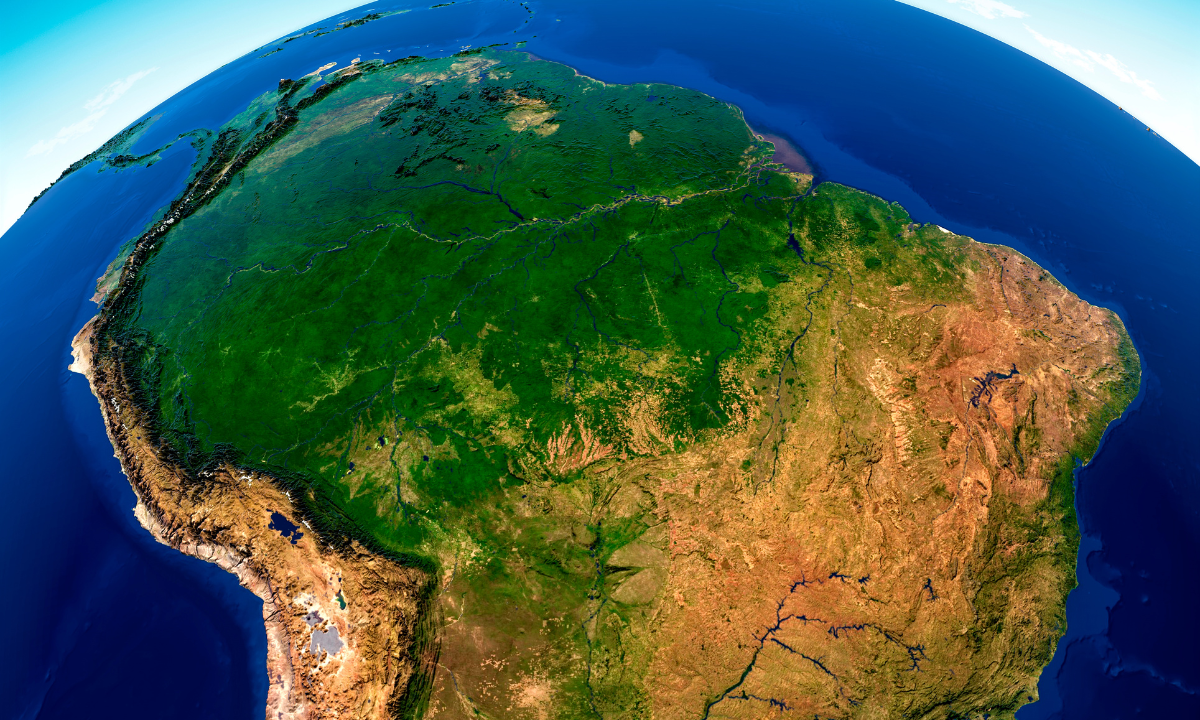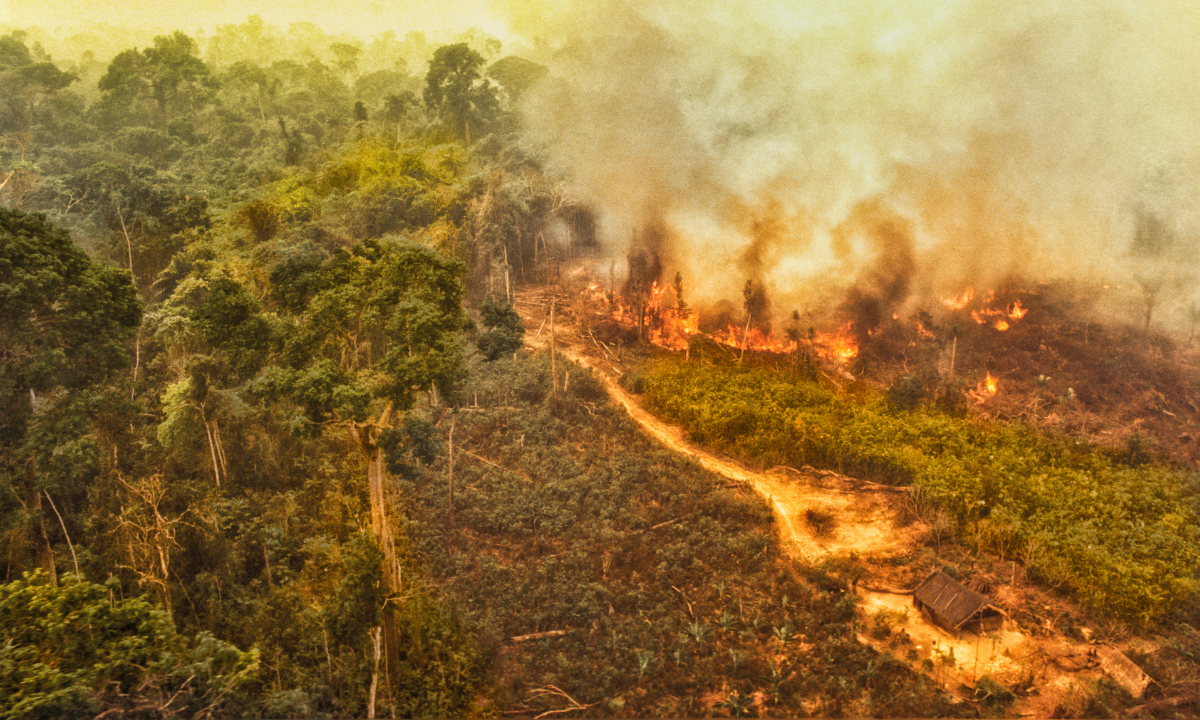Want to protect the Amazon rainforest? Build up the economies of cities nearby: Study
Why It Matters
The prevailing wisdom to prevent the further burning and degradation of the Amazon is to extract its resources sustainably. But experts say this only exacerbates the problem.

Despite what most Western populations believe, experts say the consensus that the Amazon rainforest can be protected by developing its “bioeconomy” could ultimately further its destruction.
Ricardo Hausmann, the former minister of planning in Venezuela, wrote an op-ed for Project Syndicate.org earlier this year, presenting the paradigm-shifting thesis.
“Although well-intentioned, this approach is likely to backfire,” wrote Hausmann.
“The bioeconomy’s potential has been overstated, and its actual impact is often misunderstood.”
The argument flips the international consensus that developing and promoting the bioeconomy in the Amazon is the most effective way to save the world’s largest tropical rainforest from reaching the environmental tipping point while providing a thriving livelihood for its residents.
Bioeconomy refers to “the use of renewable biological resources to produce food, energy and industrial goods, which supports sustainability,” according to the World Economic Forum.
For the Amazon, “this includes, for example, harvesting non-timber forest products like Brazil nuts, açai berries, and rubber, as well as producing and marketing creams and perfumes under the Amazon 4.0 label,” wrote Hausmann.
“The hope is that further research will discover more valuable applications, enabling conservationists to counter destructive practices that contribute to deforestation, such as cattle ranching.”
Unfortunately, Hausmann, now the director of the Harvard Growth Lab, and his colleagues argue that the bioeconomy premise is misguided at best and counterproductive at worst.
This is because the roots of deforestation and the solutions to the problem are found outside the rainforest.
Their conclusions result from a three-year study at the Harvard Growth Lab examining the drivers of deforestation and economic growth in the Colombian Amazon’s Caquetá, Guaviare, and Putumayo regions.
The project provided evidence-based policy options based on research and stakeholder engagement to protect Amazon while promoting economic development.
Deforestation without growth
“For many of the governments that have territory in the Amazon, there is a prevailing perception that there is no economic development without sacrificing the forest,” said Tim Cheston, senior manager at the Harvard Growth Lab.
South American governments believe that “letting the markets reign is driving deforestation,” Cheston said, and therefore, the only way to prevent the loss of Amazon is to exert state control.
However, recent events in Colombia disprove this view, said Cheston.
The 2016 peace agreement between the country’s government and the Revolutionary Armed Forces of Colombia led to additional state control of Amazonian regions.
Deforestation not only didn’t stop but increased, said Cheston.
“The drivers of deforestation and economic development are fundamentally distinct,” he said, meaning deforestation continues to happen even without economic development.
The productive capacities of countries such as Colombia and Brazil, which host large parts of the Amazon, lie not in the forest but in cities that are far from it, said Cheston.
On the other hand, the main driver of deforestation is “some of the least complex activities, such as cattle ranching,” he said.
Cattle ranching and land grabs
Cattle ranching in the Colombian Amazon follows a historical pattern.
“These areas of Colombia were traditionally subjected to extractive waves,” said Alejandro Rueda-Sanz, a former advisor to Colombia’s Deputy Minister of Rural Development.
“Starting maybe during colonial times, there was some demand for timber. Then rubber, then gold, and now it’s the drug-free coca.”
The extractive mindset continues today with cattle ranching, he said.
“Extractive activities just pull resources from the forest without adding much to the local economy,” Rueda-Sanz said.
“There are one or two cows on one hectare of land in Colombia,” said Cheston. “The productivity of those cows on deforested land is very low, and there are much more productive alternatives,” he said.
However, cattle ranching happens to be “the fastest way to lay claims to land,” said Cheston.
“Cows are used as a tool for land speculation,” Rueda-Sanz said. “According to Colombian law, if you use the land productively, you have a right to it,” he said.
Cattle ranching is a way to claim ownership of unclaimed land, known as baldíos or wastelands. Central to Colombia’s property rights regime, baldíos allow different actors to access land easily, Cheston said.
They are “a haven to access assets in the forest,” Rueda-Sanz said.
“These lands sometimes end up sheltering poor campesinos [farmers] who migrate there, trying to make a living. That’s a bit of the origin of the violence story in Colombia, but also tied to how settler populations started growing in the Amazon,” Rueda-Sanz said.
Baldíos is what economists call a “moral hazard, where the lack of clear property rights doesn’t prevent future claims to that land,” said Cheston.
“This creates an incentive for deforesters to clear land today and seek ownership later,” he said.

The quickest way to lay claim and clear the land is cattle ranching, making it the leading cause of deforestation in Colombia.
Additionally, the Colombian peace process had the unintended effect of increasing the “value of land by bringing the potential for more state control and connection to other areas,” said Cheston.
“We see the large role of rural roads here, where well-intentioned government investments in rural communities near the edge of the Amazon increase land value and the incentive to deforest,” he said.
“Road-building is one of the few policy actions local governors and mayors can take to demonstrate action. Colombia is a very centralized country, so there’s a political economy aspect to it,” said Rueda-Sanz.
Harvard Growth Lab’s research showed that more than “80 per cent of deforestation occurred within about 17 kilometres of built roads,” he added.
“Wherever a road was built, that area would be cleared a few months later. If you look at it from a satellite view, it even looks like a fishbone, gradually pushing into the forest as roads expand.”
Lack of productivity is the culprit
The Brazilian Amazon suffers from deforestation mostly due to reasons specific to the country’s growth model, said Marek Hanusch, a senior economist at the World Bank who was previously posted in Brazil.
“The main driver of growth is mostly the commodity sector, like agriculture,” he said.
The oversized role of the commodity sector means “Brazil isn’t very competitive in other areas, like manufacturing,” he said.
“The logic is simple: if you have productivity gains in the commodity sector, you get what’s known as Dutch disease. This typically means that one dominant sector crowds out other sectors,” Hanusch said.
“For a long time, these other sectors were protected under import substitution policies, which led to industrialization. That’s part of Brazil’s legacy. This is why the commodity sectors are so strong. Brazil just hasn’t switched away from that,” he said.
Hanusch said growth in the commodity sector happens through factor accumulation, which refers to the increase in labour, land, and capital.
How do you expand your agricultural land? Deforestation.
“If your growth model is based on factor accumulation, deforestation is inherently part of that model,” he added.
Land-grabbing is also at play. “Land-grabbing is the expectation of eventually being able to sell that land to a farmer,” Hanusch said.
“It’s indirectly linked to agricultural expansion. When you have a growth model based on land accumulation, that expectation is rational,” he said.
Like in Colombia, the primary activity on agricultural lands is cattle ranching. Not only is it just as unproductive, “cattle ranching isn’t even the primary purpose. Instead, cattle are often placed on these lands to establish ownership claim,” Hanusch said.
This lack of productivity is the story in Colombia as well.
“If you look at our non-oil exports, they have stagnated,” Rueda-Sanz said. The lack of economic opportunity pushes people in two directions: the informal urban sector or the extractive sector in the Amazon.
Bioeconomy: more of the same
Why, then, would the bioeconomy not save Amazon? According to experts, the bioeconomy perpetuates the same dynamic as cattle ranching; it puts pressure on an already depleted forest.
The argument against the bioeconomy is that it “also generates demand for land,” Hanusch added.
“The land market doesn’t care what generates demand for land. It only cares that there is demand for land, whether it’s bioeconomy or cattle ranching,” he said.
An increase in demand leads to a rise in the price of land, which means it will be “rational for farmers to expand the land to keep production costs low or for landgrabbers to grab more land because the price has just increased,” Hanusch said.
Moreover, “the promise of the bioeconomy has been overhyped,” said Cheston.

“Many local products have not reached an international audience. Only acai has reached a significant audience,” he said.
“In Brazil, is it enough to sustain 30 million people who live in the Amazon?”
An increase in demand for bioeconomy products would also encourage monoculture, according to Hanusch.
“Vast areas of monocultures is a very cheap way of making profits. That’s not by accident; that’s economics,” he said.
Acai’s popularity offers a cautionary tale, which started in a very sustainable way and then slipped into monoculture, Hanusch said.
Lastly, according to Rueda-Sanz, bioeconomy products are easy to greenwash. He said that only an expert can differentiate between berries produced following high environmental standards and those that don’t.
Urbanize to protect the forest
Deforestation results “from a lack of urban or promising higher-income activities, which is driving more resources and more people into the forest,” said Cheston.
Yet, cattle ranching does not lead to economic growth because the needs of the populations in Colombia and Brazil are fundamentally different.
Most of the Amazon population in both countries lives in cities, not the forest. Of the 30 million residents of the Brazilian Amazon, 24 million live in urbanized areas.
In Colombia, the Amazonian city of Florencia has half a million dwellers – and is located three hours away from the forest.
“That’s where there’s a mismatch,” said Hanusch.
According to the researchers, Amazon’s cities must become financially attractive to prevent forest loss.
“If you have higher productivity in cities, they are less likely to expel people into the forest. It will relieve the pressure on the agricultural frontier,” Rueda-Sanz said.
“It’s about a different growth model that comes from a completely different perspective,” Hanusch said.
“There has to be an alternative growth model to de-incentivize land grabbing,” he added.
“The way out of putting pressure on the forest is not by putting more resources into the forest. It’s by putting more resources into cities,” Cheston echoed.
“The more cities become prosperous and labour-absorbing and provide higher income alternatives to earning a living at the forest’s edge, the more people will move into the cities.”
“The beauty of our argument is that it’s a simple argument. This is how every country develops. Every country eventually switches from a rural-led model to an urban-led model,” Hanusch said.
He called the solution a win-win, as this growth model supports development and is consistent with conservation, as it reduces the demand for land.

